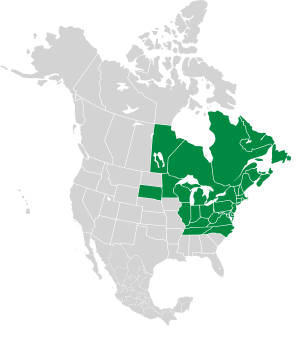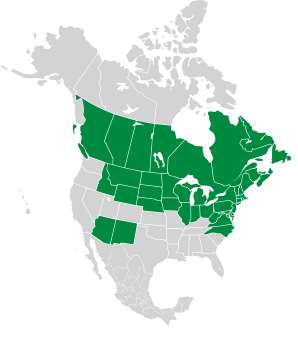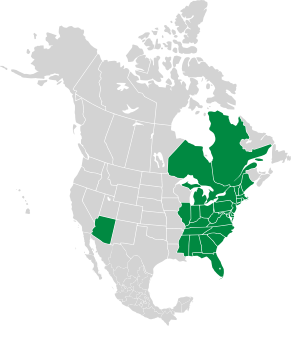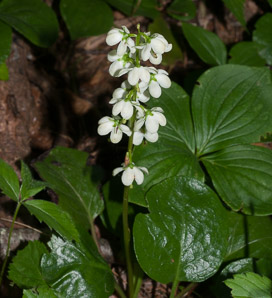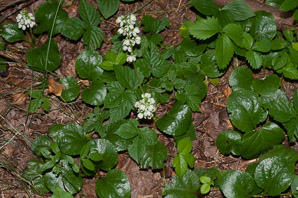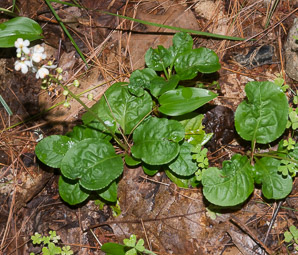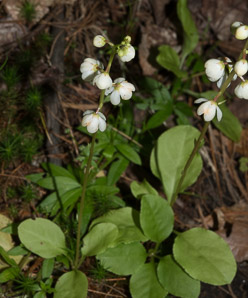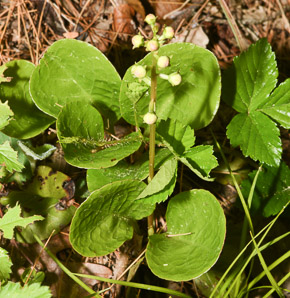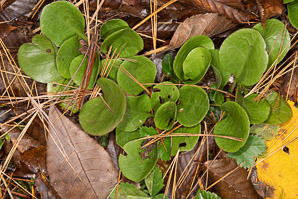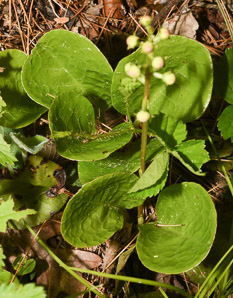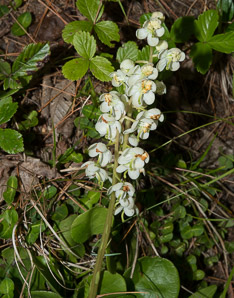|
Pyrola americana Sweet
Rounded shinleaf, American wintergreen
| Kingdom | Plantae | Plants, but not fungi, lichens, or algae |
| Subkingdom | Tracheobionta | Vascular plants—plants with a “circulatory system” for delivering water and nutrients |
| Division | Magnoliophyta | Flowering plants, also known as angiosperms |
| Class | Magnoliopsida | Dicotyledons—plants with two initial seed leaves |
| Subclass | Asteridae | A large class that encompasses asters |
| Order | Ericales | Tea, persimmon, blueberry, Brazil nut, azalea, many others |
| Family | Pyrolaceae | Includes at least Chimaphila, Moneses, Orthilia, and Pyrola, and sometimes several genera usually placed in the family Monotropaceae |
| Genus | Pyrola | Pear-like, from the Latin diminutive of Pyrus, meaning “pear,” for the pear-like leaf shape, and a genus commonly called shinleaf or wintergreen |
| Species | americana | “Of or from America” |
About plant names...
Rounded shinleaf is native to North America. It prefers moist forests at elevations
below 1.3 mi (2.1 km).
Plants: Leaf clusters are low-lying, only
1½-2″ (4-6 cm) tall, while flower stalks reach up to 1′ (30 cm).
Leaves: Leaves emerge from the base of the plant,
in a basal rosette.
They are quite round, or sometimes egg-shaped, and shiny, with a vein structure that makes them look pleated or
rippled. Leaf edges are very slightly scalloped. Leaves are 1-3″ (2.5-7.6 cm) around.
The leaves are so low that they are often overtopped by leaves from surrounding
plants.
Flowers: On flower spikes (racemes) with 3 to 22
hanging flowers. Each flower is white, cream-colored, or pink or rarely red, ½-¾″ (1.3-1.9 cm) around, with
five round petals. There are 10 yellow or brown-tipped stamens, and a green pistil
which extends
well beyond the flower.
Fruits: A dry capsule 1/16-⅛″ (3-3.5 mm) around.
Medical: Leaves of plants in this genus contain an
aspirin-like compound that has been used to make a poultice to treat bruises and wounds.
The poultice, called shinplaster, is the source of the common name “shinleaf.”
|
|

7/2/2017 · Wildlife Pond, Beaver Brook Conservation Area, Hollis, New Hampshire · ≈ 7 × 4½″ (18 × 12 cm) 
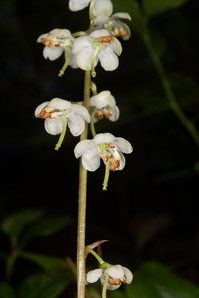
7/2/2017 · Wildlife Pond, Beaver Brook Conservation Area, Hollis, New Hampshire · ≈ 2½ × 4″ (7.3 × 11 cm) 
|
| Plant |
Leaf clusters are low-lying, only 1½-2″ (4-6 cm) tall, while flower stalks reach up to 1′ (30 cm). |
Leaf clusters are low-lying, only 1½-3″ (4-8 cm) tall, arranged in basal rosettes. Flower stalks reach 4-10″ (10-25 cm). Usually there is a single flower stalk; occasionally there are two. |
A low-growing plant (about 9″ (22 cm)) that inhabits forest floors. |
| Flowers |
On flower spikes (racemes) with 3 to 22 hanging flowers. Each flower is white, cream-colored, or pink or rarely red, ½-¾″ (1.3-1.9 cm) around, with five round petals. There are 10 yellow or brown-tipped stamens, and a green pistil which extends well beyond the flower. |
On flower spikes (racemes) with 3 to 21 hanging flowers. Each flower is white or greenish-white, ¼-½″ (8.3-12 mm) around, with five rounded petals. Petals sometimes have green veins. There are a cluster of orange-tipped stamens, and a green pistil which extends well beyond the flower. At the base of each flower are five sepals, forming a green star. Flowers appear from June to August. |
Nodding white flowers about ½-¾″ (1.3-1.9 cm) across appear on red-brown stalks. Each stalk is tipped by 2-5 curving stems, each holding a downward-hanging flower. Each flower has 5 white petals, 5 light green sepals, ten stamens, and a green pistil. Flowers appear from late spring to early summer. |
| Leaves |
Leaves emerge from the base of the plant, in a basal rosette. They are quite round, or sometimes egg-shaped, and shiny, with a vein structure that makes them look pleated or rippled. Leaf edges are very slightly scalloped. Leaves are 1-3″ (2.5-7.6 cm) around. |
Leaves emerge in a basal rosette from the base of the plant. They are dull, oval, 1-3″ (2.5-7.6 cm) long and ½-2″ (1.5-5 cm) wide. Leaf edges are very slightly scalloped. The leaves are so low that they are often overtopped by leaves from surrounding plants. Leaf stalks are shorter than the leaf blades. |
Thick, low-lying, leathery, waxy-looking leaves are dark blue-green when mature, much lighter when young. They have a prominent central white vein that branches out on larger leaves. The leaves are about 1-3″ (2.5-7.6 cm) long and ¼-1″ (6.3-25 mm) wide. In the winter, the evergreen leaves turn purple. Leaf margins are dentate, with shallow, widely spaced teeth. |







